Germany and Hapag
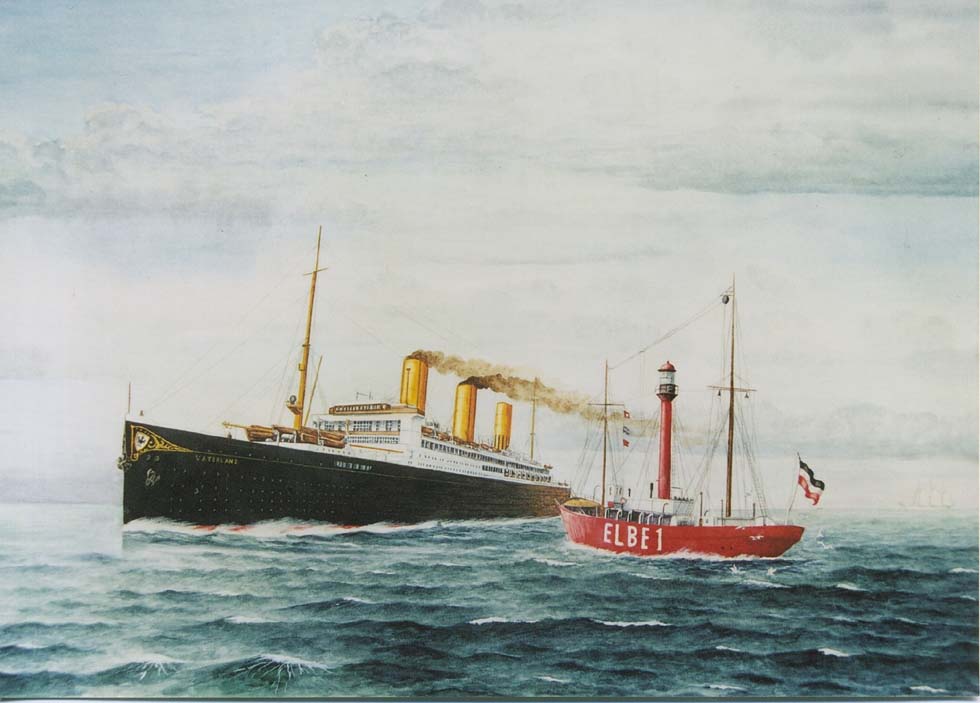
"Vaterland" in the mouth of river Elbe (painting by Heribert Schroepfer)
Germany Takes Hold of Maritime Power
Unlike the British deep sea navigation, which had grown in a steady progress, the German mercantile shipping was subdued to a change of up and down. In this connection it seems worth mentioning, that Germany had been nothing more than a geographical but no national term since the late Middle Ages. The beginning of a sea trade from ports of the North and the Baltic Sea can be traced back to the early 13th century, when German tradesmen joined together to form the Hansa, which developed by the time to the mightiest and most successful trade federation. In the same degree as the British merchant fleet had gained on influence, the Hansa lost on importance. It was Kurfuerst Friedrich Wilhelm of Brandenburg coming to the throne in 1640, who felt again the need of a merchant fleet. He entered in a trade and navigation agreement with England and put up the Orientalische Handlungs-Companie. But when the country has become a kingdom in 1701, the interest in navigation declined again, leaving a moderate coastal business. The German deep sea navigation had fallen to an absolute low point.
Economic hardness and political and religious oppression had been for many Germans a reason to start a new life overseas. A report of a voyage over the Atlantic in the year 1837 has been delivered by the traveling journalist Friedrich Gerstecker: "Now I will do my pains to describe you the between deck as exactly as anyhow possibly. Imagine a room of 11 paces in length and 9 paces in breadth, 8 feet high and on each side fitted with sleeping places for 10 men in every bunk to lay in, 5 above and 5 below. Imagine now this space (...), in which are also piled up the boxes and trunks of the emigrants, even along the bunks. Imagine only, that in this space at bad weather 110 to 115 emigrants are being locked in, imagine their transpiration, their laughter, running, vomit, wailing, children screaming (...) and you will get rather an idea of this room."
After the failed revolution of 1848, emigration had been the sole way to escape from persecution and imprisonment. America promised a life in freedom and safety. By 1854, the emigration from Germany had reached with 252,000 persons a climax and got increased by other tens of thousands from Eastern Europe. Most emigrants depended on American ships, but also German ship-owners realized the opportunity to enter this business. In 1850, Robert Miles Sloman, whose father with British roots had initiated a service with sailing ships between Hamburg and American ports, opened, a steamship route with the small but well-appointed iron-built screw-steamer "Helena Sloman" of 800 tons. She took 22 days for a westward crossing and 18 days eastwards, berthing 74 cabin passengers and 236 emigrants. On her 3rd Atlantic crossing she got holed in a storm and drifted steerless towards the Newfoundland Coast. In last minute the shipwrecked were salvaged through a passing sailing ship, except 9 passengers who drowned when their lifeboat capsized. This was the rapid end of a promising enterprise. Sloman relied thereafter only on his cargo business.
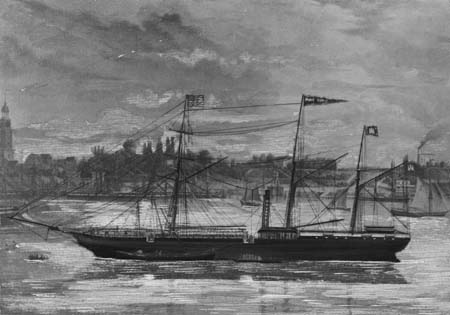
"Helene Sloman" on her first departure for New York, 1850 (Deutsches Museum Munich)
|
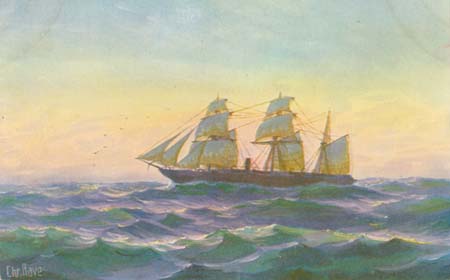
"Borussia" of 1856, Hapag, painting by Chr. Rave (old card, coll. WS)
|
Hapag's Rise to the Peak
On 27 May 1847, a new company was founded in Hamburg under the management of Senator Adolph Godeffroy to initiate a mail and passenger service to North America with four sailing ships: the Hamburg-Amerikanische Packetfahrt Actien Gesellschaft, later mostly abbreviated to Hapag. When since 1848 the stream of emigrants called for more tonnage, the Hapag decided for steamers. While the sailing vessel took six or more weeks for a passage, the steamship could do it in a third of the time within a regular schedule.
In 1855 the Hapag took delivery from the British Caird Shipyard of two steamships, the "Hammonia" of 2,026 tons and the "Borussia" of 2,131 tons, to operate at a speed of 10 knots, berthing 200 cabin passengers and 310 emigrants in the between deck. In their appearance they looked like sailing ships dismissing a lot of black smoke. Before they could take up their service in 1856, they had been chartered for troop transports in the Crimean War. In 1857, two somewhat bigger ships, "Austria" and "Saxonia" of 2,684 tons each, joined the small fleet forming the starting point for a unique story of success. But only a year later, a catastrophe overshadowed the bright scene, when on the "Austria" fire broke out and 449 persons lost their lives. As a result of the increasing traffic, Hapag took delivery of two other ships, the "Bavaria" (2,405 tons) and the "Germania" (2,123 tons), and after the sale of the aging "Hammonia", the "Alemannia" (2,665 tons) went on her maiden voyage to New York in 1865 while the "Bavaria", renamed "Petropolis", changed onto the Central American and Brazil trade. At the same time, Baltimore and New Orleans became new terminals, the latter suspended again in 1874 for disappointing results.
Hapag had increased its passenger fleet by 13 other ships of 2,110 to 3,600 tons which provided good service but could not match the contemporary British and French liners of more than 5,000 tons. And once again Hapag was afflicted by a sad loss: On her way home from New York in August 1869, the "Germania" ran aground at Cape Race. Passengers and crew could be salvaged. The 1870s were marked by a decline of passengers which made 13 steamers unemployed. The takeover of the competing Adler Line brought however fresh blood into the Hapag fleet. The overhanging tonnage was sold to French companies, the US Navy and to the Russian Volontary Fleet. From 1871 onwards all ships were thoroughly modernized and re-engined. Soon, further bad blows hit the company. In 1878 the "Pommerania" (3,382 tons) sank after collision with a British bark in the English Channel claiming 55 victims and the "Cimbria" (3,025 tons) got lost when she collided with the British steamer "Sultan" shortly before reaching her homeport at Borkum island after returning from New York in 1883, taking 437 down with her.
Incidentally in 1880 the economic situation turned into an upward trend and necessitated again the addition of new tonnage. Primarily, orders for two top-liners were placed, in that case now with German shipbuilders: That for the "Rugia" (3,409 tons) went to the Vulcan of Stettin and that for the other, the "Raetia" (3,553 tons), to the Reihersteg Werft of Hamburg, taking up service in 1882 resp. 1894, the "Rugia" departing from Stettin. The positive trend continued over the 1880s. While in 1879 25,000 emigrants had left Hamburg, their number rose by 1881 onto 123,000. The lack of direct connections to American ports forced many travelers to change ships in English ports. To remedy this inconvenience, a trampship-owner, Edward Carr, took the chance and fitted out 6 of his cargo steamers for passenger conveyance. In 1886 he associated with the Union Line which entered in a pool contract with the Hapag the same year. Combined with the contract was the appointment of the traveling agent Albert Ballin as Administrative Manager of the Hapag. Thus, the 1st of May 1886 became one of the most memorable dates in the company's history. This young managing talent developed the third-class enterprise into the mightiest shipping company in the world.
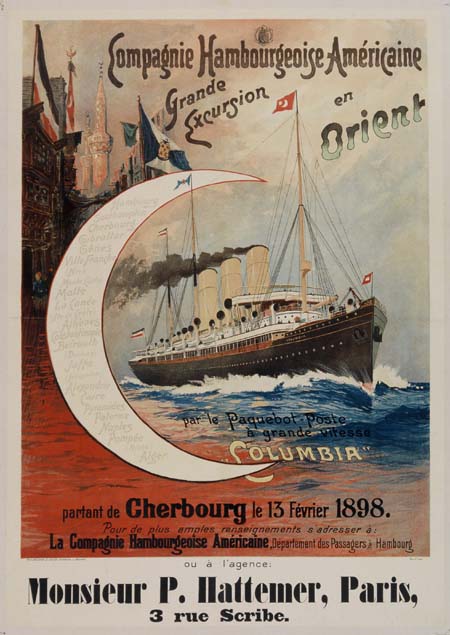 "Columbia" of Hapag, French ad (coll. Juergen Klein)
"Columbia" of Hapag, French ad (coll. Juergen Klein)
Between 1889 and 1891 two new ships joined the Hapag fleet, which took advantage of a number of technical innovations, as the triple and quadruple expansion compound engine, steel construction instead of iron, and above all, the double screw propulsion as an element of more safety. For the first time also German shipyards had been included in the programme. As the first, Hapag received in April 1889 from Vulcan of Stettin the 7,661-ton liner "Augusta Victoria" (later put correct to "Auguste Victoria"), followed shortly after by the "Columbia" (7,576 tons) from Laird, in May 1890 by the "Normannia" (8,716 tons (8,716 tons) from Fairfield and in 1891 by the "Fuerst Bismarck" (8,874 tons) again from Vulcan. The "Auguste Victoria" was the third double-screw express-liner after Inman's "City of New York" and "City of Paris". Hapag offered the fastest and best-organized North Atlantic service of the time and with regard of popularity, it took the top position. Managing 19,75 knots, its new ships were hard on the heels of Inman's record holders with 20 knots. During the winter season several Hapag liners served for some time a Genoa - New York route. "Auguste Victoria" went in 1891 on an Orient cruise and was chartered in 1895 by the Government for the opening ceremony of the Kaiser-Wilhelm-Kanal connecting the North with the Baltic Sea. In 1904 she was sold to the Russian navy, followed by "Fuerst Bismarck" in 1909, while the "Normannia" went to Spain in 1898. Hapag's rise was abruptly stopped by the outbreak of a bad cholera epidemic in 1892 which brought all shipping activities to a sudden standstill for about a year. The disease had been probably brought in by emigrants from Eastern Europe. Of the 144,383 persons having departed from Hamburg in 1891, 76,791 came from poorly civilized regions. Improved medical and hygienic care and the establishing of a separated emigrant district extinguished the epidemic.
With the revival of business, Hapag felt the necessity to replace older steamers of the 1870s by ships of a new pattern, the P-Class, so designated because of their names with "P" as initial letter. Out of the 9 ships, six of 5,800 to 6,700-tonners were placed onto the North Atlantic route in 1894/95. The other three of about 13,000 tons, the "Big Ps", followed between 1896 and 1899. These simply styled steamers for an operational speed of 12 to 13 knots, marked by two funnels and three masts accommodated 200 to 340 cabin passengers and 2,300 emigrants in changeable between decks. The revived emigration and cargo business helped Hapag to become the greatest shipping enterprise in the world, owning a total of 440,000 registered tons. The construction programme of 1893 comprised 16 steamers of 5,300 to 6,500 tons, designated as "A" -Class and 5 of the bigger "B"-Class of about 10,000 tons, managing 12 knots. Except of well-furnished First and Second Class cabins, they provided mainly accommodation for emigrants and got assigned onto the routes to Boston, Baltimore, Philadelphia and Montreal. One can hardly claim any aspect of grace for these four-mast single-funnel ships. Nonetheless they formed the bread-and-butter base for Hapag's North Atlantic business.
Hapag, which owed its success primarily to Ballin's pragmatic policy, seized in 1903 the opportunity to acquire from Harland & Wolff two uncompleted ships of about 18,000 tons predestinated for the emigration business. Commissioned by the British Wilson & Furness Leyland Line, their provided names "Servian" and "Scotian" had been changed into "President Lincoln" and "President Grant". As with many ships of British design their profile was marked by the separation of the bridge from the upperworks with the single funnel upon, but what had been unique was the installation of six masts which brought them in the nickname "The Boehmerwald" (Bohemian Forest). Although lacking of any grace, they made good profits for the company. After taking delivery of the medium-sized two-funnel liners "Moltke" and "Bluecher" of 12,335 tons for 15.5 knots, Hapag was keen attracting over and above a highly pretentious clientele. To keep pace with White Star's "Celtic" and "Cedric", a double-screw liner of 22,225 tons was commissioned with Harland & Wolff and named "Amerika". When she went on her maiden voyage to New York on 11 October 1905, the international press was full of praise for her extraordinary comfort. Quite a similar liner, the "Kaiserin Auguste Victoria" of 24,581 tons, constructed at Vulcan of Stettin, took up service in May 1906. Each of the two ships was for some time the largest one in the world. Although operating at a speed of only 17.5 knots and taking 2 days more for an Atlantic crossing against the express liners, they proved being a great success and confirmed Ballin's strategy. In spite of their more on tonnage, they consumed only half the quantity of coal. As a welcome innovation was adopted the introduction of a Third cabin class, provided especially for emigrant families being prepared to pay a slight supplement.
Although Ballin was not fond of the racing for the Blue Riband, he consented into the intention of the Hapag Board to take part in order not to lose on image. In July 1900, the elegant "Deutschland" of 16,502 tons from Vulcan of Stettin, in her appearance quite similar to NDL's "Kaiser", came fully up to Hapags expectations. Already on her maiden voyage on 4 July 1900 she won the Blue Riband, peaking 22,42 knots. Hapag's triumph was however soon spoilt. Unlike her rival of Bremen, the "Deutschland" suffered terribly from vibrations to such an extent, that she caught the nickname "The Cocktail-shaker". But it came still worse: In April 1902, on her return from New York, she lost her rudder with a part of her stern. Because no means could be found to eliminate the failure, the ship was sent in 1910 to Vulcan to be converted into a de-luxe cruise ship for First Class passengers only.
Ballin, who has never favoured the maritime expresses, restored his former policy when new tonnage was needed. In 1909 Hapag took delivery of a medium-sized twin pair, the "Cincinnati" and the "Cleveland" of about 17,000 tons. Following the generally raised standard of living, also the emigrant accommodations presented improvements (in 1919 the "Cleveland" had to be handed over to the U.S. Shipping Board and sailed thereafter as "Mobile" for the U.S. Army and Navy. After some further changes of ownership and names, she finished her days under her prior name as a single class ship at Hamburg. "Cincinatti", after being confiscated by the U.S. authorities, was torpedoed by a German submarine and got lost).
Superliners
When in 1907 Cunard's Blue Riband-winners "Lusitania" and "Mauretania" finished the "decade of the Germans" and White Star was going to commission a trio of super liners, 50 percent bigger than those speedsters and double the size of Hapag's last acquisitions, Ballin got worried about the company's leading position. A project of a 30,000-ton ship with Harland & Wolff was not carried on. The Administration Board consented eventually to three ships which should clearly surpass those of the White Star. Hapag's order for its first superliner went to the Vulcan which had erected a new shipyard at Hamburg, because the installations on the mouth of the Oder at Stettin could not keep pace with the rapid growing of ship sizes.
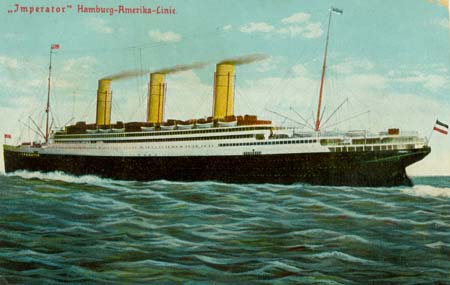
"Imperator" (old card, coll. WS)
|
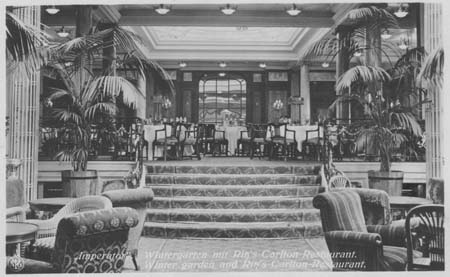
"Imperator", Ritz's Carlton Restaurant (old card, coll. WS)
|
In 1912, 6 weeks after the "Titanic" catastrophe, Hapag's first superliner was launched and baptized by the German Emperor on the name "Imperator". With her 52,117 tons she started as the largest ship of the time. This performance is in so far remarkable as it has been achieved - unlike with Cunard's record breakers - without a government support. The "Imperator" set complete new standards in passenger appointments. She presented not simply a bigger conventional ocean liner, but realized the impression of a floating town of dimensions and luxury never seen before, surpassing even that of many of the finest hotels. Interior design was by French architect Charles Mewes. No question that also the technical equipment took full advantage of the last developments. Triple expansion steam turbines, developing 84,000 shaft-h.p., drove four propellers and helped the giant managing 24 knots, only slightly below Cunard's record. Three high funnels and well-balanced proportions marked Germany's new pride at sea. Except of much praise from the international press, the "Imperator" received also critical comments. Apart from the extravagant luxury it aimed especially at her unusual figurehead, showing a half-relief globe surrounded by a corona of rays and a huge eagle figure upon. In terms of the one or other improper phrase of the Kaiser, the representation had been interpreted as an expression of German imperialism. Albert Ballin, although being a personal friend of the Kaiser, can hardly be supposed of that. His and his company's leading principle ("The World is our Field") meant nothing more as every economically orientated enterprise strives for: to expand its operational field and making good profits. Anyhow, the figurehead seemed being unnecessary and did not really contribute to the grace of the ship. In the end the argument was solved by nature when the object under dispute was destroyed in a storm.
The "Imperator" disposed upon a berth capacity of 908 First, 972 Second, 934 Third and 1,772 Tourist Class passengers. To improve the ship's lacking stability, most of the overweight by marble and heavy wooden furniture was removed from the upper decks and the funnels were shortened by 3 meters. She started her maiden voyage on 20 June 1913 from Cuxhaven to New York. The port of Cuxhaven at the mouth of the Elbe was connected since 1889 by special trains from Hamburg for Hapag. Three years after her maiden voyage, the "Imperator" was laid up at Hamburg for the period of World War I and was thereafter handed over to the Cunard Line. Thoroughly modernized and renamed "Berengaria", she operated from 1921 between Liverpool and New York as flagship of Great Britain's merchant navy. Damaged by fire at New York harbour she was scrapped in 1938.
Hapag's second superliner surpassed its forerunner by about 2,000 tons. This time the order was placed with Blohm & Voss of Hamburg. Launched on 3 April 1913 and measuring 54,284 tons the ship was baptized by the Crown Prince of Bavaria on the name of "Vaterland" (originally planned as "Europa"). Her maiden voyage took place on 1st May 1914 as partner of "Imperator". In her principle outlines she followed her in general, but featured some technical and architectural improvements. To provide an unhindered passage through the saloons, the smoke diversion to the funnels was laid at the sides. The raised engine power of 90,400 h.p. enabled her to a speed of 25.5 knots. Hapag's pride did however not last for long. After her maiden voyage and three other Atlantic crossings, World War I broke out, while the "Vaterland" laid at New York harbour. When the USA had declared war on Germany in 1917, the ship was confiscated and served as "Leviathan" for the Navy during the period of the war. Extensively modernized and enlarged to 60,000 tons, she started a new life as the largest ship ever sailing under the Stars and Stripes. In spite of her high comfort, the "Leviathan" operated not very successfully on her Southampton - New York route, considered as a following of the Prohibition Law of the United States. In 1938 she was sold for scrapping at Rosyth, Scotland.
The order for Hapag's third superliner went again to Blohm & Voss. It surpassed the "Vaterland" once again by 2,000 tons. Launch and baptism ceremony was made again a national event in presence of the Kaiser. Countess Hannah von Bismarck baptized the ship on the name of the founder of the united Germany, "Bismarck". With outbreak of war the equipment works were stopped. After the end of hostilities, the ship was completed under British supervision and went as "Majestic" to the White Star Line in 1922, having never sailed under German flag. Until the advent of the "Queen Mary" she took the place as flagship of the British merchant fleet. Converted to a stationary training ship in 1936 and renamed "Caledonia", she burnt out in 1939 and was broken up a year later.
From WWI to WWII
Before World War I had broken out, Germany owned a merchant fleet of 2,090 vessels totaling 5.1 million tons, ranking second in the world behind Great Britain with a total of 20.5 million tons, but ahead of the USA with 2 million tons. War losses had Germany's merchant fleet diminished to c. 600,000 tons. In accordance to the Treaty of Versailles of 1919, all ships of more than 1,600 tons including those under construction had to be handed over to the Allied Shipping Controller Board. Port facilities and docks abroad had been expropriated. The defeated Germany had become a republic, the Kaiser left the country and Albert Ballin, who could not bear the ruin of his life-work, died tragically. To the Hamburg-Amerika Line, once the greatest shipping enterprise in the world, only a volume of 82,000 tons had been left. The only ocean-going passenger ship to remain was the "Victoria Luise", the former Blue Riband-winner "Deutschland" and later de-luxe cruise ship. Her bad condition rescued her from delivery. Rebuilt to a Third-Class ship renamed "Hansa" and with two of her 4 funnels removed, she resumed Hapag's New York service in 1921, but was laid up in 1924 for scrapping.
The first German ship that docked after the war at New York was Hapag's "Bayern", more likely a passenger/cargo steamer of 9,014 tons, put in operation in 1921. Managing only 12 knots, she was no match for the competitors of other nations. Nevertheless the Americans gave her a hearty welcome. To the same general design, three other steamers were put in service in 1923/24: "Wuerttemberg" (8,900 tons), "Thuringia" (11,343 tons) and "Westphalia" (11,343 tons). They operated only for a short time on the North Atlantic and were transferred to the La Plata route. Hapag's effort to regain a noteworthy position in the North Atlantic business did however never slow down. To overcome the lack of tonnage, the company reacquired two of its 20,000 ton liners of 1914. These most elegant three-funnel liners, named "William O' Swald" and "Johann Heinrich Burchard", originally intended for the La Plata route, could never take up this service by outbreak of war. The one, still completed at the Tecklenborg Yard, was sold in 1916 to the Koninglijke Hollandsche Lloyd of Amsterdam. According to the reparation regulations, the deal was not acknowledged by the victorious powers. Through a trick the Germans succeeded to get the ship through the British control to Amsterdam. Her sister followed after completion in February 1920. They were introduced by the Dutch on the Buenos Aires route, but proved too large for that market. Both liners were sold, reportedly in order to avoid diplomatic complications with the British government. The United American Lines, which was part of the Harriman Group, introduced them as "Reliance" and "Resolute". They operated on the New York - Hamburg route and Hapag entered into a contract with the UAL for an operational association. In 1926 the ships returned without changing names into the full ownership of the Hapag. From 1927 they carried the company's new funnel colours of yellow with top rims in the ancient national colours of black, white and red.
Thanks to their sound comfort and their good keeping at sea, both ships won the favour of the traveling public. A machinery utilizing a combination of 2 triple expansion engines combined with an exhaust-turbine between, working on three screws, helped the ships to manage 18 knots. In 1928 they were exclusively refitted for de-luxe cruises. Becoming known as Hapag's White Ladies they earned special fame for the 123-days round the-world-tours starting from New York and finishing at San Francisco after visiting 29 countries. In 1935 the "Resolute" was sold to the Italian government. Renamed "Lombardia" and registered with Flotte Riunite Italia, she was used as a troopship in the Ethiopian War. In 1943 she was sunk by an Allied air attack on Naples harbour. Her sister, damaged by a fire at Hamburg in 1938, was sent for scrapping to Bremerhaven in 1941.
Back to the days of Albert Ballin, he thought already during the war about the ships policy for the time after. Considering the expected decline of revenues and incomes, the possibly highest degree of economy should be made the guiding principle, but impression of austerity should prevail. That means a reasonable luxury for the First, solid comfort for the Second and a good standard for the Third Class. First of a commissioned quartet, launched at Blohm & Voss in 1923, was baptized on the name of Hapag's Great Man, "Albert Ballin", and placed on the North Atlantic route the following year. The turbine-powered twin-screw 20,815-ton-ship managed 16 knots at an extraordinarily low fuel consumption and accommodated 204 First, 340 Second and 960 Third Class passengers in a tasteful up-to-date comfort. Her outer appearance was characterized by high but short upperworks carrying two straight funnels and four masts. In 1934, after a call at Bremerhaven, she struck a harbour tug which sank with 4 screw hands. Later, twice rebuilt and equipped with more powerful turbines, her tonnage had increased to 21,121 and her speed to 19 knots. In consequence of the anti-Semitic laws of the Nazi-government, Hapag was forced to rename the ship into "Hansa" in 1935. During World War II she was used as a housing ship for the navy and was at last employed in the evacuation action from the approach of the Red Army. In one of these operations she struck a mine. After disembarkation of the refugees she capsized near Warnemuende. Repaired by 1955, she served as "Sovietsky Soius" for Sovtorgflot at Vladivostok and was eventually scrapped after a career of 58 years.
Three sisters had followed in 1923: "Deutschland" (20,602 tons, after modernization 21,046 tons), following closely the design of "Albert Ballin", and refitted the same way with some further changes (two masts removed), the "Hamburg (21,132 tons, later 22,117 tons) and the "New York" (21,455 tons, later 22,337 tons), each constructed at Blohm & Voss, too. The "Hamburg" shared the bad fate of the "Hansa" running on a mine. Hoisted and converted into a whale factory, she discontinued her career in 1977. Sister "New York" was sunk by bombs, hoisted and broken up in Great Britain in 1949. For the Hapag, no other ship had operated as effectively as everyone of this quartet. Apart of the matter of accommodation, the excellent cuisine, the perfect service and last but not least the application of stabilizers which reduced the rolling at heavy sea, they had been preferred by many travelers to bigger consorts of other lines.
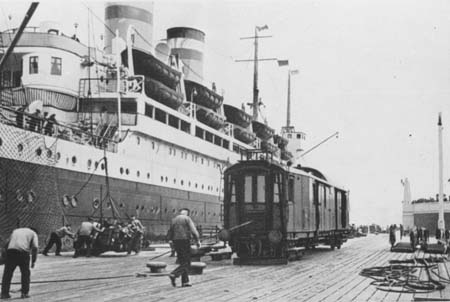
"Albert Ballin", Cuxhaven in the 20s (DB Verkehrsarchiv)
|
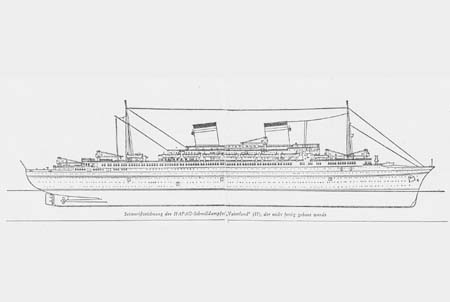
The uncompleted second "Vaterland" (old press)
|
Hapag, having been a promoter of the motor ship, entered into contracts for the construction of two 17,000 ton diesel-powered liners, the "St. Louis" with the Vulcan of Bremen-Veegesack and the "Milwaukee" with Blohm & Voss of Hamburg, each powered by 4 diesel engines on two screwshafts enabling them to manage 16 knots. Greatest acknowledgement they acquired on cruises which went especially for the "Milwaukee". For that usage she was equipped in 1935 as a First-Class ship in white livery. She survived the war as a housing ship and sailed thereafter as "Empire Waveney" for Cunard. After a fire-damage she was scrapped in 1946.
Much appreciation received the "St. Louis" by her courageous Captain Schroeder when she had left Hamburg with 937 Jewish asylum seekers on board for Cuba. Although in possession of immigration papers, neither this country nor the United States gave permission for embarkation. After an odyssey over five weeks in the course of which Schroeder contacted several countries, the governments of Belgium, the Netherlands, France and Great Britain gave asylum to the desperate Jews. Had Captain Schroeder returned to Germany as the Nazis had him expected, they would have been sent to a concentration camp with poor chance to survive. Thanks to the worldwide attention being paid to the affair, Captain Schroeder was only displaced from his post. After the war he was honoured by the government of Israel. The "St. Louis" was used as a hulk during the war and as a hotel ship thereafter in Hamburg. In 1950 she was broken up at Bremerhaven.
The End
Although the number of passengers had declined by more than 50 percent since the 1920s, every year new tonnage produced an overcapacity in the passenger business. Towards the late 1930s it became nonetheless evident that Hapag needed new ships to keep pace with its competitors. To provide an optimal passenger service, the policy of a mixed passenger/cargo operation should not be retained. Top-liners like the "Queen Mary" of Cunard (80,774 ts, 29 knots), "Normandie" of CGT (79,280 ts, 29 knots), "Bremen" of NDL (51,656 ts, 28 knots) and "Rex" of Italia (51,062 ts, 28 knots) were to figure not simply as means of communication between the continents. Over and above they represented their countries abroad. Therefore governmental support became more and more indispensable. Hapag planned to introduce three 41,000-ton liners. By interference of war only one could be launched at the Blohm & Voss yard in 1940, the order for the other ones had to be cancelled. The design had provided a ship of extraordinary grace, perfectly proportioned, sporting a clipper bow and two slightly inclined short funnels in Hapag's house colours, and laid out as for line service as for cruises, accommodating either 297 First, 456 Second and 467 Third Class passengers or 500 single class when going on round-the-world-travels, or 1000 for short trips. Two turbo-electric power units driving two propellers should have enabled to keep 23.5 knots at economic operation costs and a maximum of 25.5 knots. Not the name "Deutschland" (II), as presumed by some sources, but "Vaterland" (III) was chosen. The outbreak of World War II forced to stop the construction work. On 25 July 1943 the torso was set on fire in an air attack and led to its breaking up in 1948.
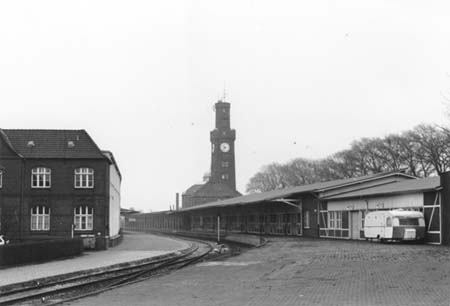
Cuxhaven Steubenhoeft, empty in 1982 (WS)
|
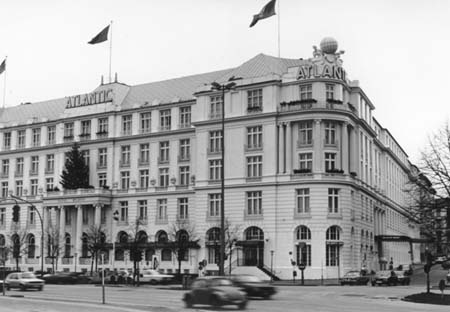
Hamburg, Hotel Atlantic (WS)
|
With the sad end of this uncompleted liner, Hapag's regular passenger services on the North Atlantic have gone for ever. Today the Steubenhoeft terminal at Cuxhaven, the port and the noble Hotel Atlantic in Hamburg are memorials of the epoch when Hamburg and Hapag were symbols of the way from Germany to the New World.
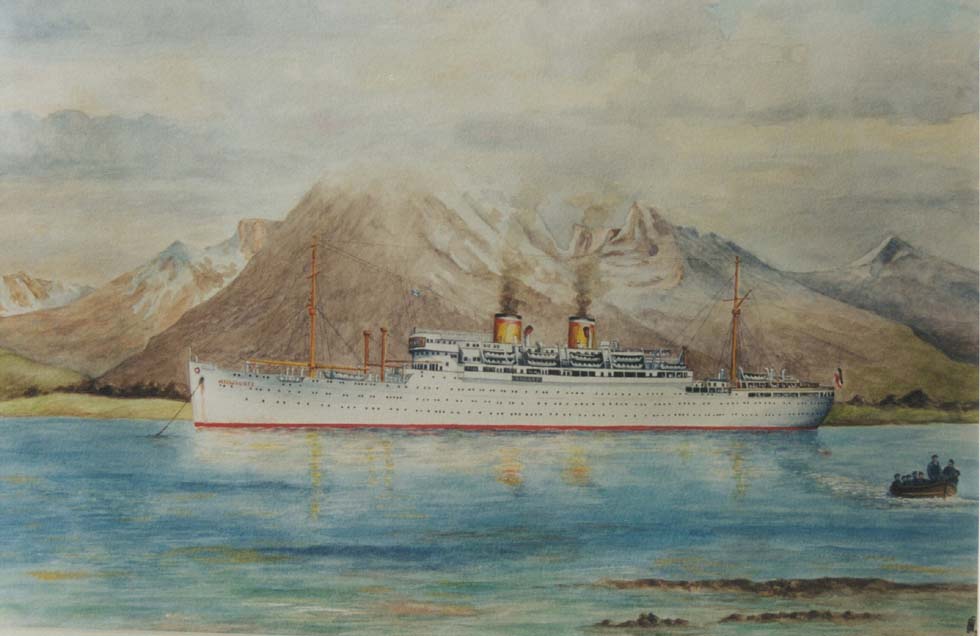
"Milwaukee", sister of "St. Louis", on a Spitzbergen cruise (painting by Heribert Schroepfer)
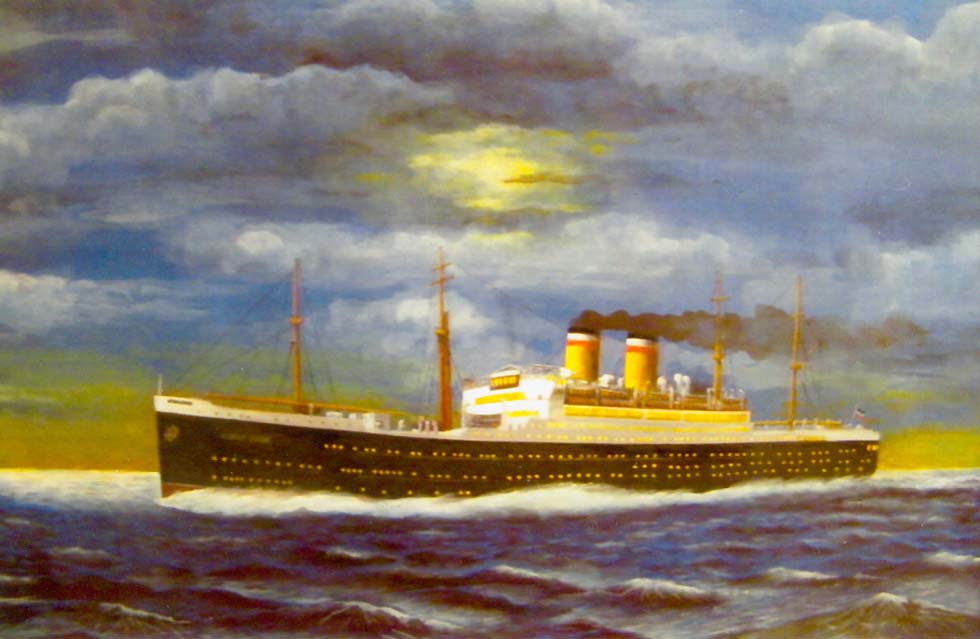
"Albert Ballin" of Hapag in the 1920s (painting by Heribert Schroepfer)
|